DNA Structure & Analysis - Chapter 9 Biology Study Guide
1/102
There's no tags or description
Looks like no tags are added yet.
Name | Mastery | Learn | Test | Matching | Spaced |
|---|
No study sessions yet.
103 Terms
DNA is the
genetic material
genetic material has three properties
-storage and expression of information
-replication
-variation through mutation
work with bacteria and bacteriophages shows that shows that
DNA is the genetic material
griffith's experiments (1927) on Streptococcus pneumoniae
-something from IIIS "transforms" IIR
-chemical substance is involved
-physiological vs. genetic
-living R + heat killed -> S virulent
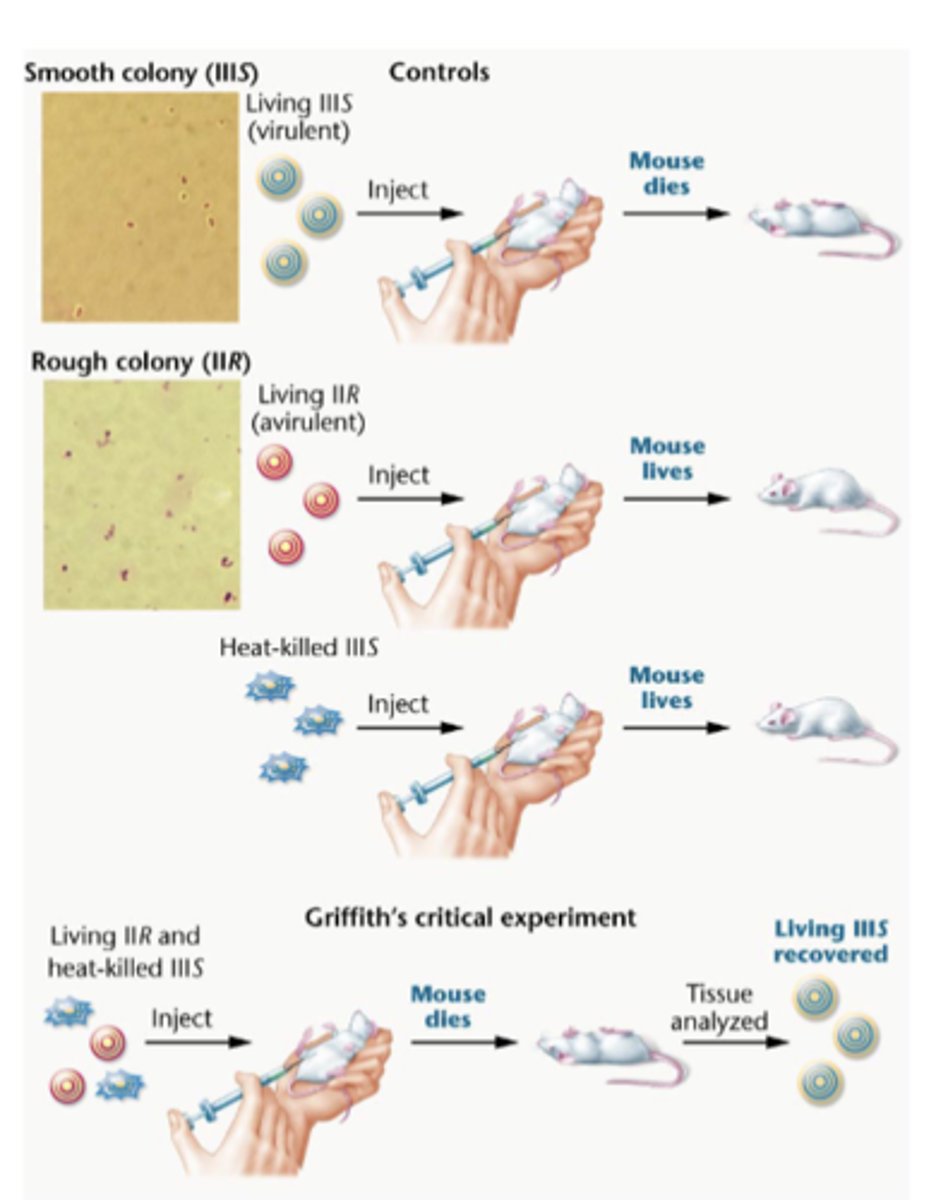
Streptococcus pneumoniae
-rough strain: avirulent
-smooth strain: virulent
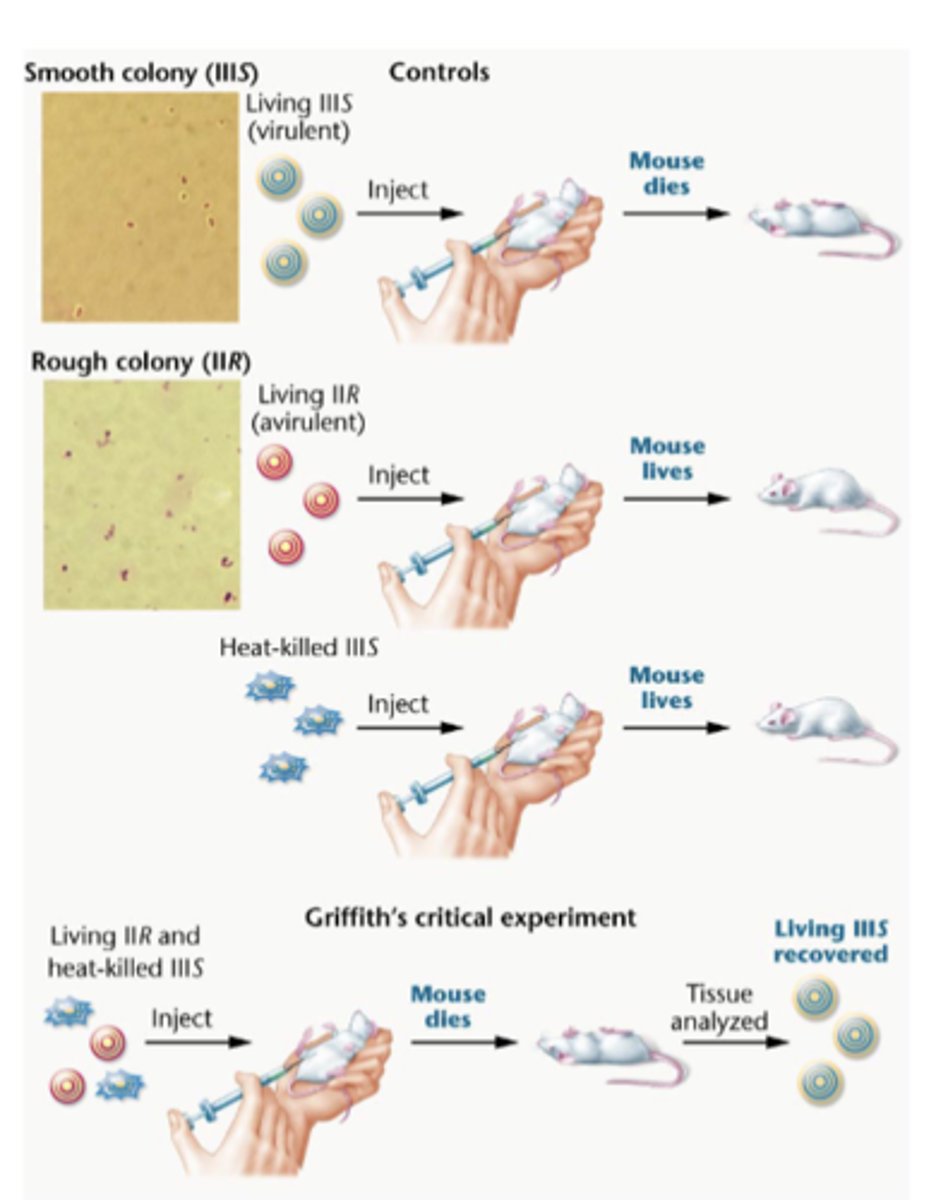
Avery, MacLeod, and McCarty (1944)
-"nucleic acid of the deoxyribose type" is the transforming agent
-once transformation occurs, it is heritable
1. protease 2. RNAse 3. DNAse
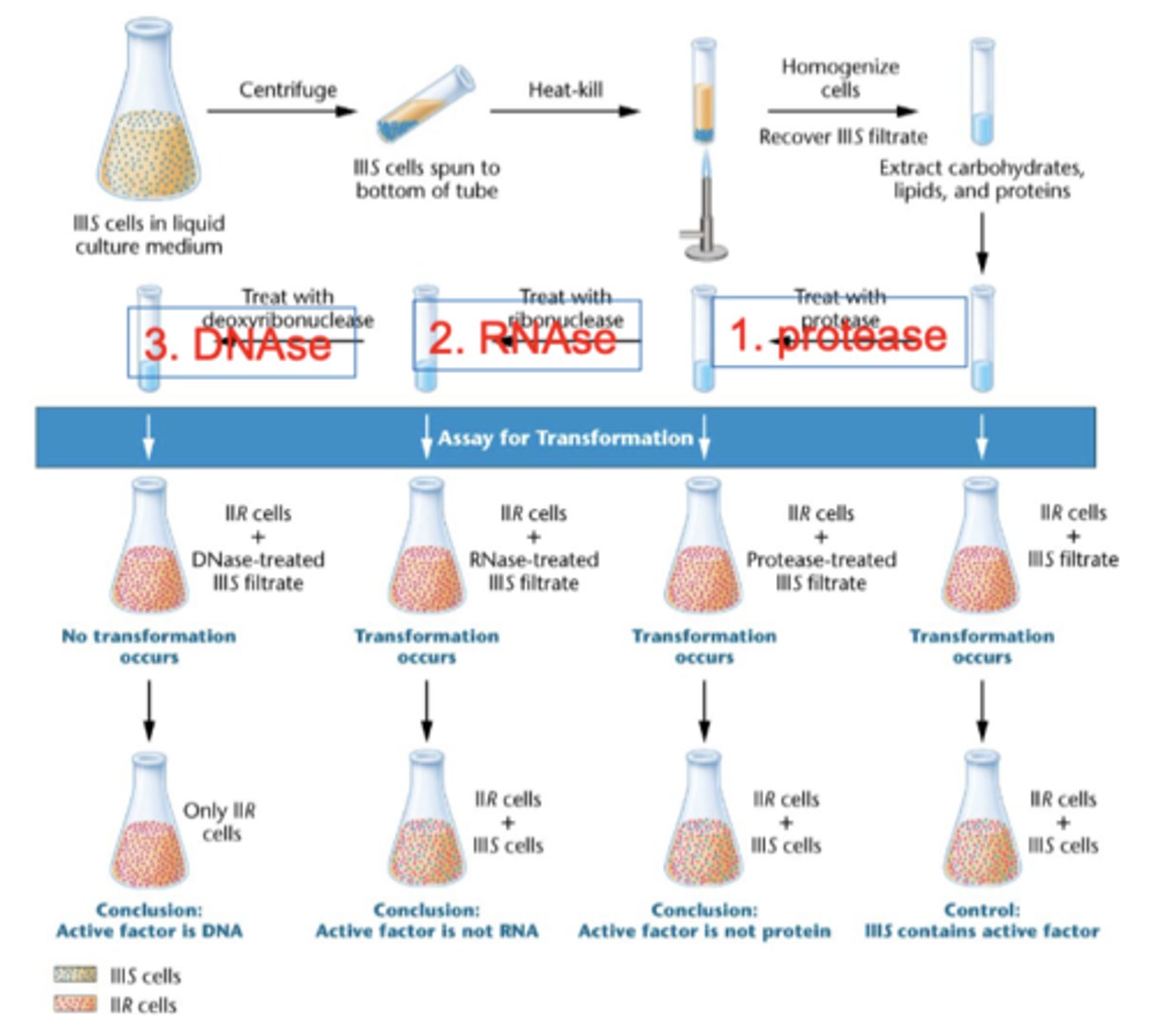
transfection experiment provided the conclusive evidence that
DNA is the genetic material
transfection
the process of infection by viral DNA only into bacterial cells
hershey & chase show that DNA is the
genetic material in bacteriophages (1952)
bacteriophage has
DNA and protein
phage is made up of
50% protein and 50% DNA

hershey and chase experiment
-DNA labeled 32P
-protein coat labeled 35S
-viruses were isolated
-infect E. coli w labeled viruses
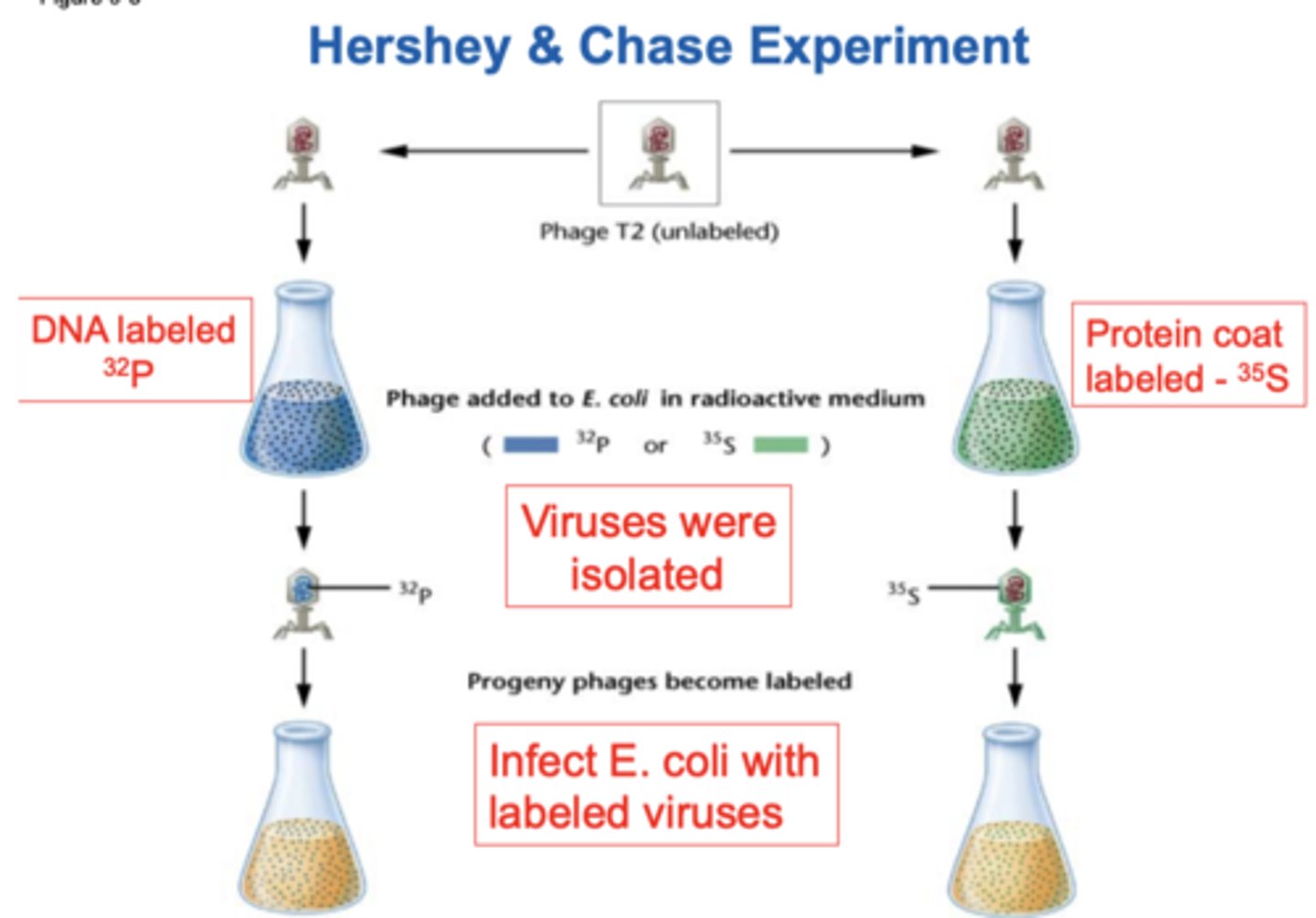
end of hershey and chase experiment
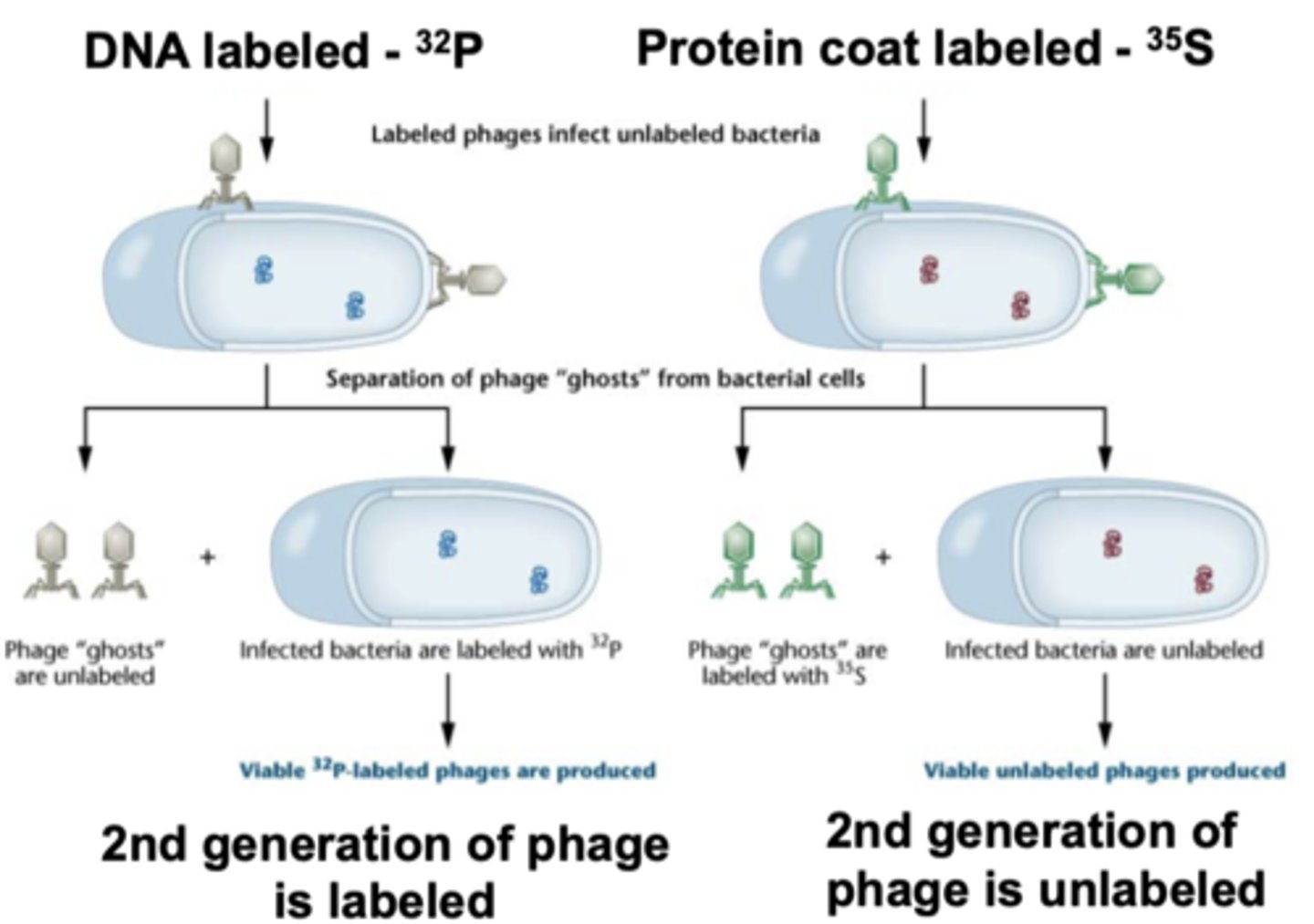
strongest direct evidence for DNA as the genetic material comes from
recombinant DNA technology
segments of eukaryotic DNA corresponding to specific genes are
isolated and spliced into the bacterial DNA
presence of the eukaryotic gene product in bacteria containing the eukaryotic gene provides
direct evidence that this DNA is present and functional in the bacterial cell
DNA is the genetic material in
all organisms
RNA viruses do not have
DNA
-e.g. Tobacco Mosaic Virus
-RNA genome
-protein coat
RNA as the
genetic material in some viruses
experiments with tobacco mosaic virus (1956) demonstrated that
RNA serves as the genetic material for these viruses
replication of the viral RNA is dependent on
RNA replicase
other RNA viruses
retroviruses
biochemical nature of the genetic material influences
the biology of a virus
retroviruses replicate in an
unusual way
RNA serves as a template for
synthesis of a complementary DNA by the RNA-dependent DNA polymerase called reverse transcriptase
this DNA (reverse transcriptase) can be incorporated into
the host-cell genome
when transcribed, copies of the original retroviral RNA chromosomes are
also produced
-HIV
structure of DNA holds the key to understanding its
function
biochemistry is the basis for
life
DNA is a
polymeric macromolecule
DNA is
a nucleic acid
nucleotides are the building blocks of
DNA
nucleotides consist of
-nitrogenous base
-a phosphate group
-a pentose sugar
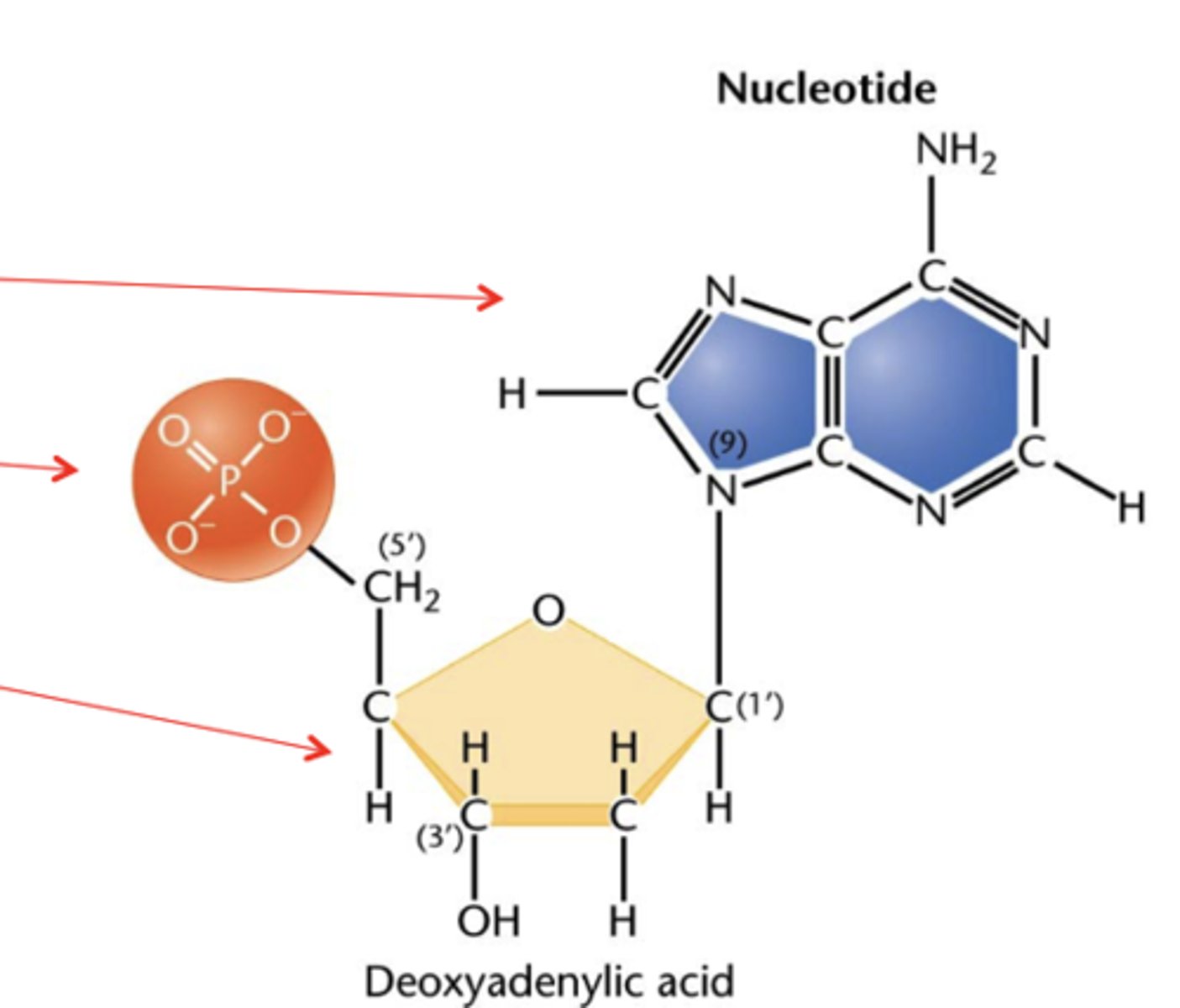
nitrogenous bases end in
ine
-cytosine
-thymine
-uracil
-guanine
-adenine
components of DNA have descriptive terms that
indicate what each unit includes
nucleoside contains the
nitrogenous base and the pentose sugar
nucleotide is a
nucleoside with a phosphate group added
(deoxy)ribonucleosides can be
mono- di or tri-phosphorylated
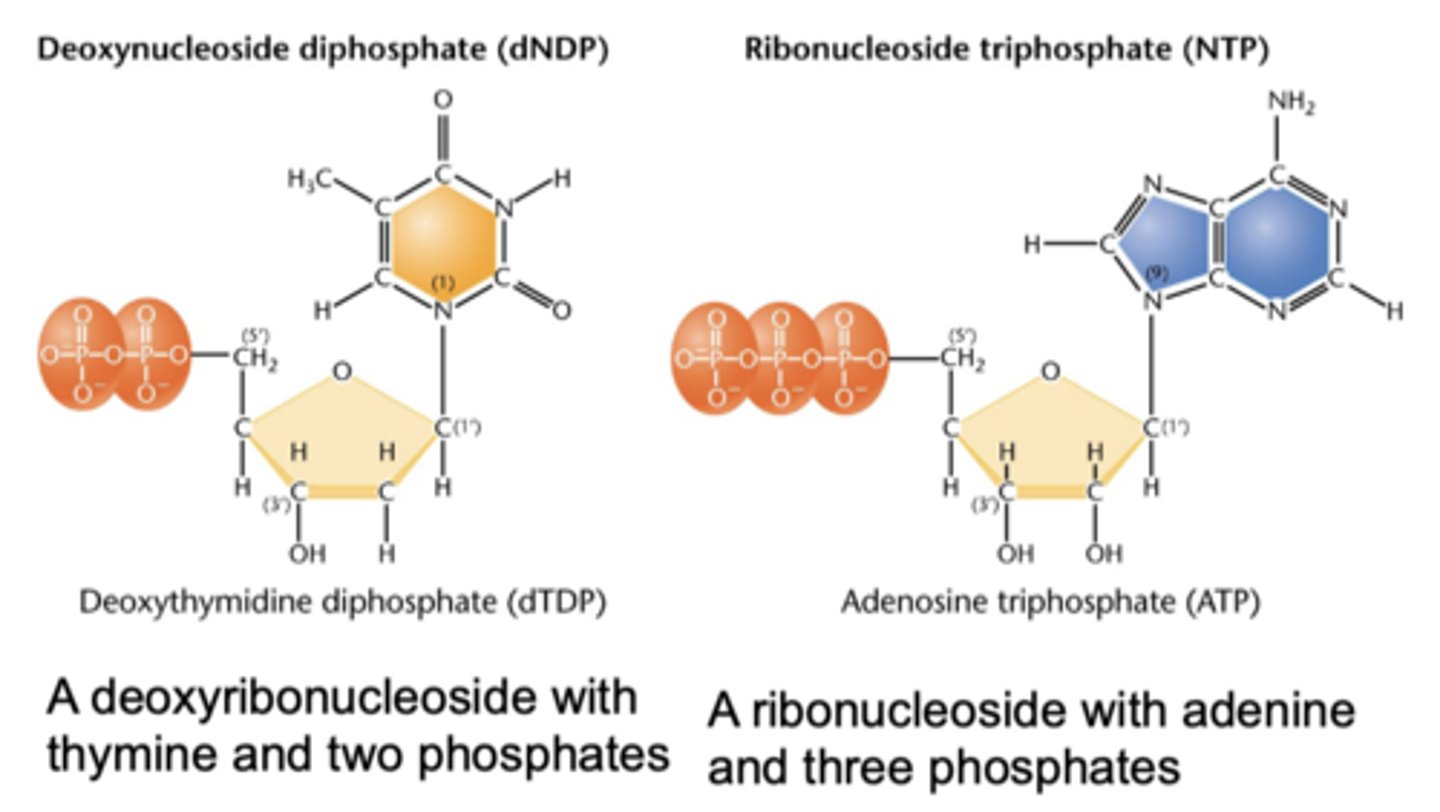
biological DNA is a
directional polymer of nucleotides
nucleotides are linked by a phosphodiester bond between
the phosphate group at the C-5' position and the OH group on the C-3' position
oligonucleotides
short chains consisting of up to 20 nucleotides or so
polynucleotides
longer nucleotide chains
oligo/polynucleotides
-store vast amounts of genetic information
-give rise to extraordinary variation
DNA goes from
5' to 3'
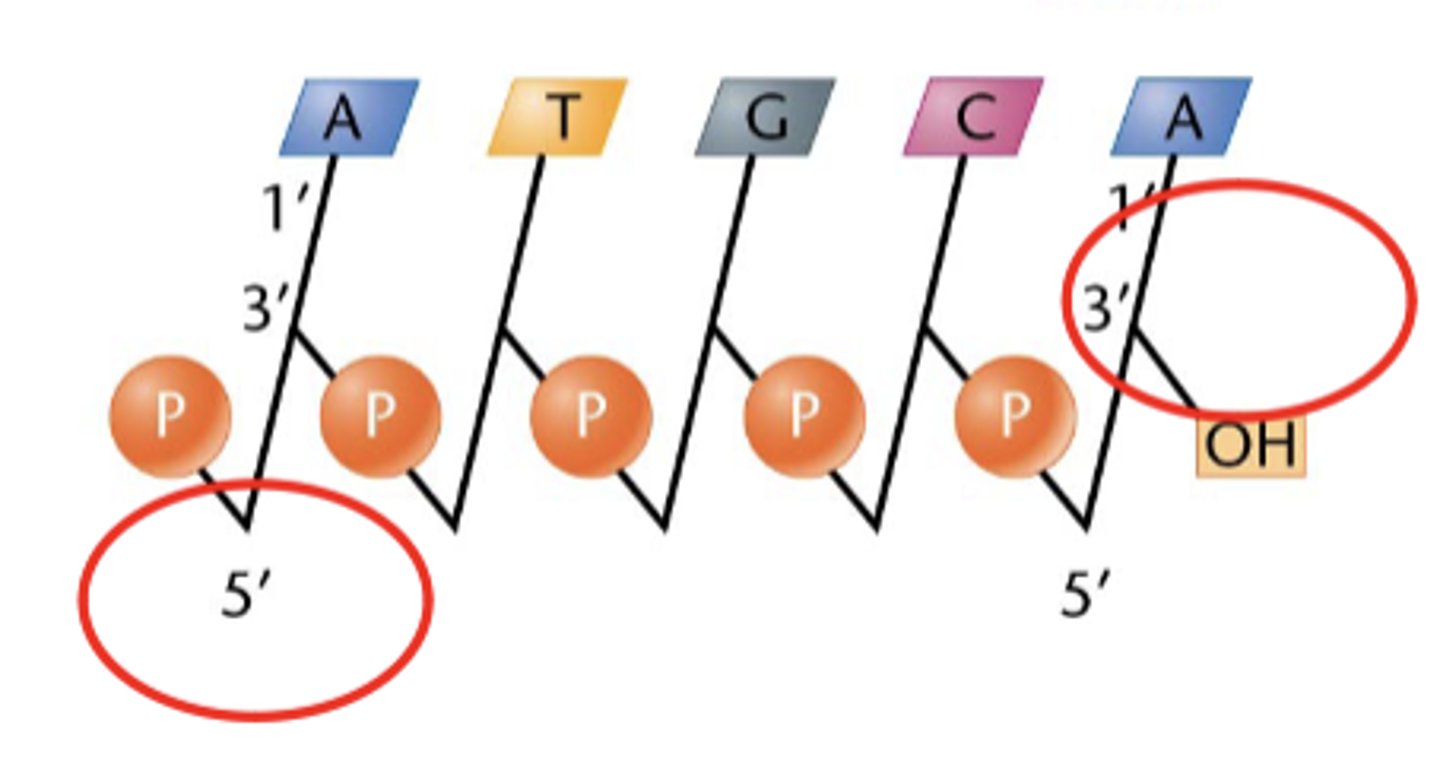
forming these 3'-5' phosphodiester bonds is the basis of
DNA synthesis

early observations gave important clues about the
structure of DNA in cells
with base composition studies, Chargaff and his colleagues quantitatively demonstrated that
-amount of adenine is equal to amount of thymine and amount of guanine is equal to amount of cytosine (A = T & G = C)
-the sum of purines (A + G) = sum of pyrimidines (C + T)
-percentage of (G + C) is not necessarily equal to the percentage of (A + T)
Erwin Chragaff's data
A = T & G = C
X-ray diffraction studies by Rosalind Franklin (1950-1953) of DNA showed a
3.4 angstrom periodicity, characteristic of a helical structure
Watson-Crick Model incorporated
base composition and x-ray diffraction to describe structure of DNA
Watson and Crick (1953) proposed that DNA is a
right-handed double helix in which the two strands are antiparallel and bases are stacked on one another
two strands are connected by
A-T and G-C base pairing
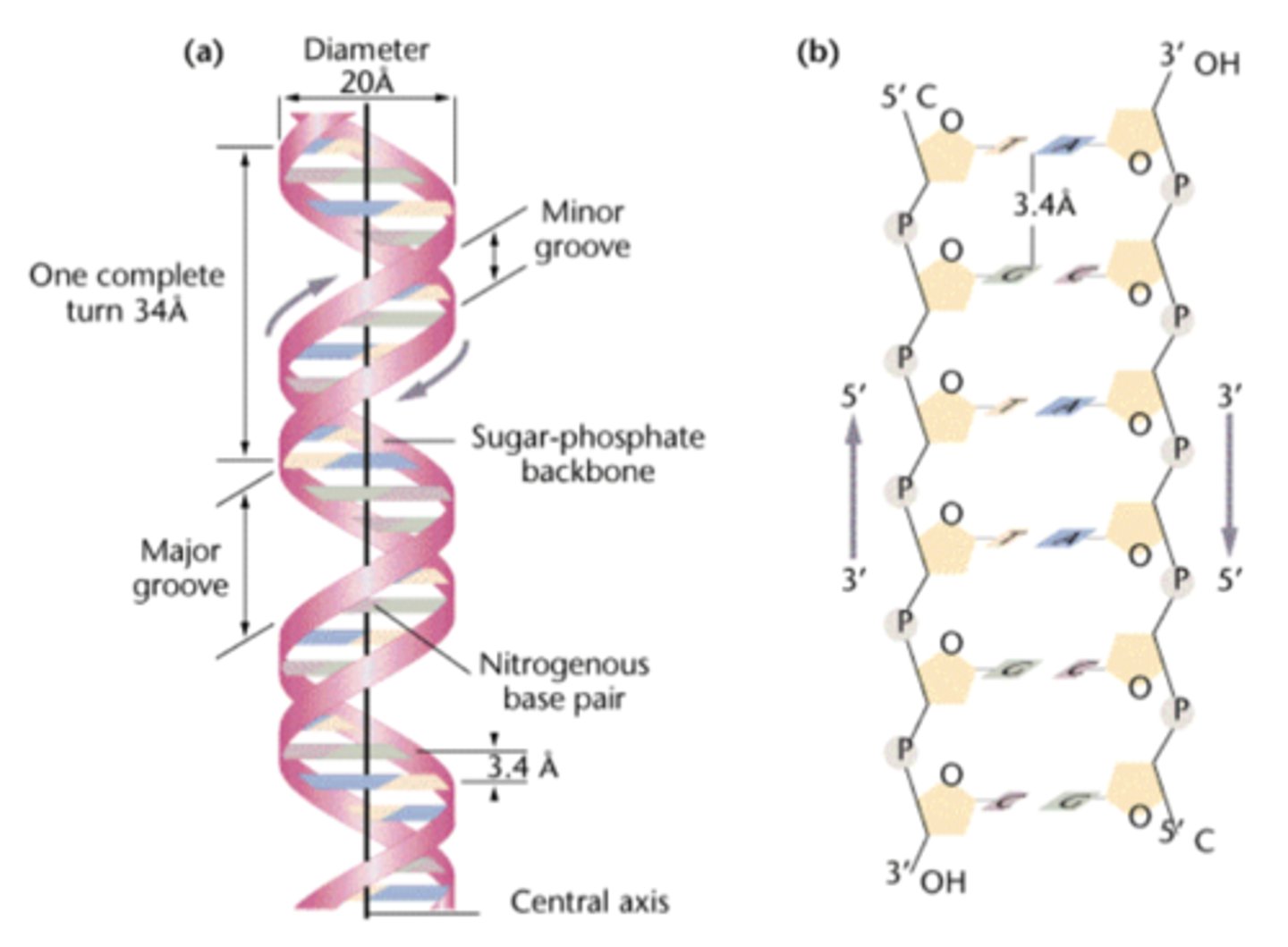
there are ____ base pairs per helix turn
10
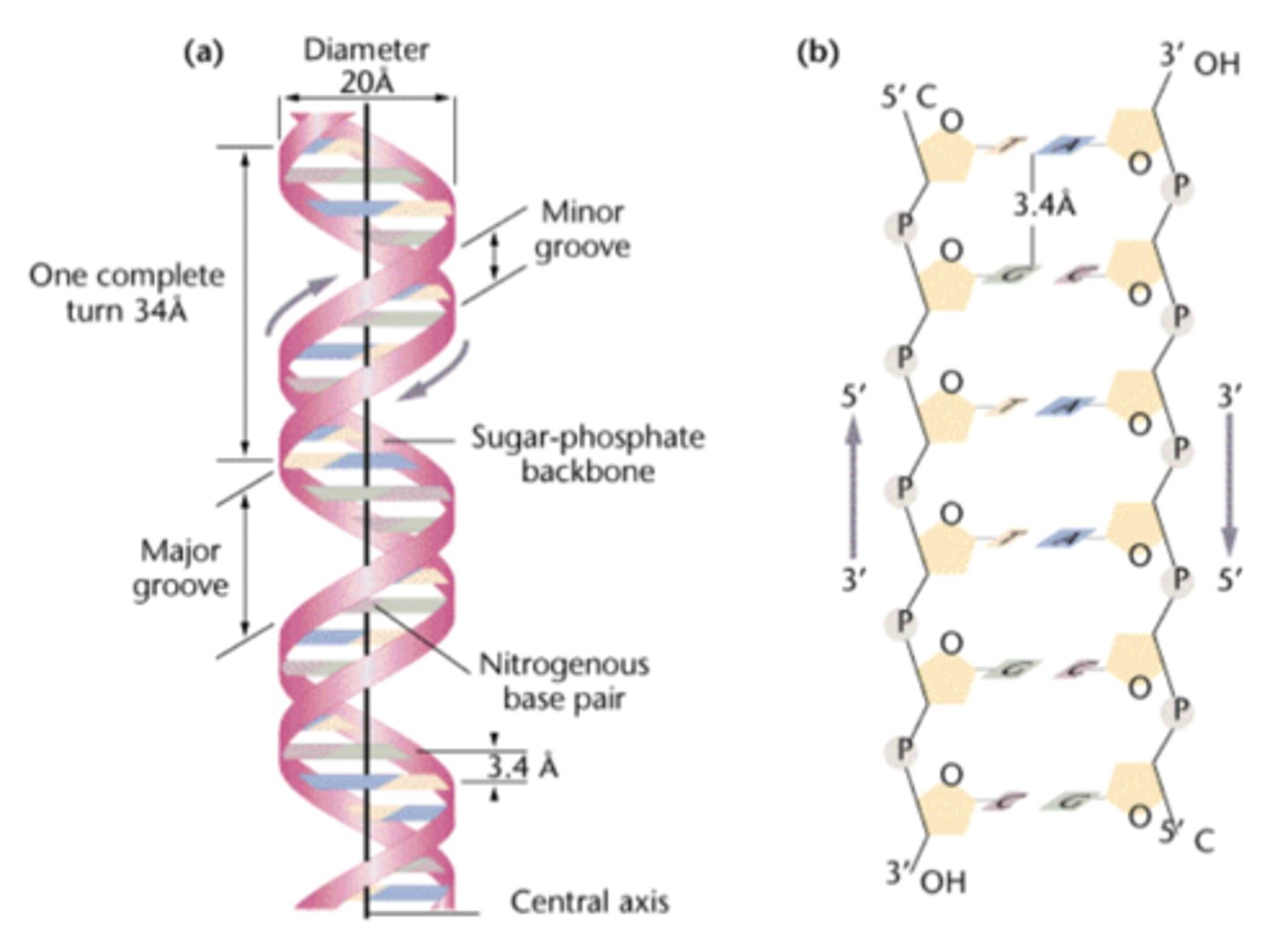
Watson and crick model is the currently accepted model for
the structure of DNA in cells
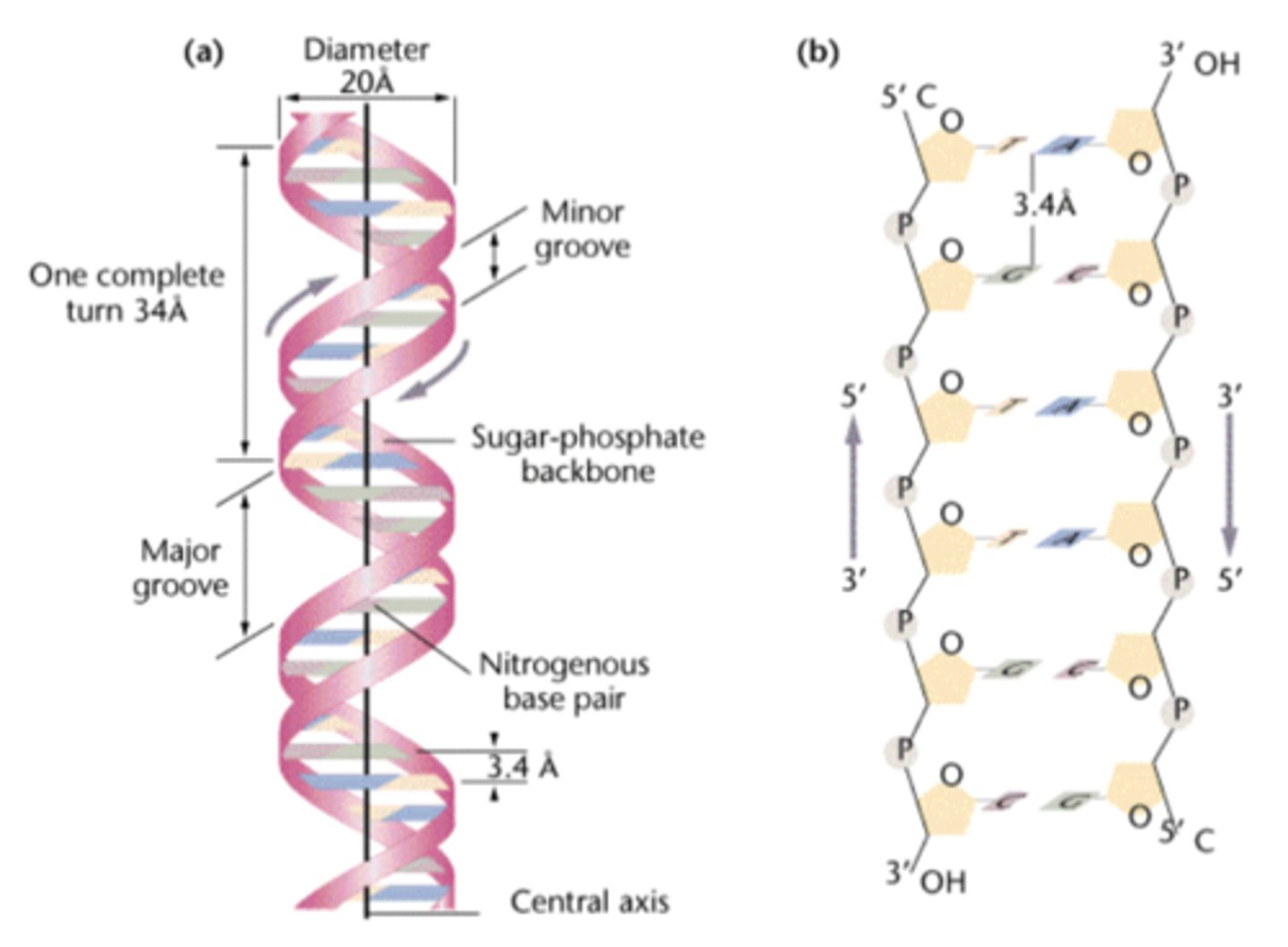
base composition data relates to
complementary base pairing in the DNA molecule
A-T and G-C base pairing provides
complementarity of the two strands and chemical stability to the helix
two strands are
antiparallel
one chain runs
5'-to-3', whereas the other runs 3'-to-5'
the structure is critical to how the dna molecule is
synthesized
dna is a very stable molecule
-H bonds in middle
-SP backbone
-double stranded
DNA
double helix held together bycomplementary base pairing
A-T has ___ hydrogen bonds
2
G-C has ___ hydrogen bonds
3
physical/chemical properties of DNA depend on its
G+C %
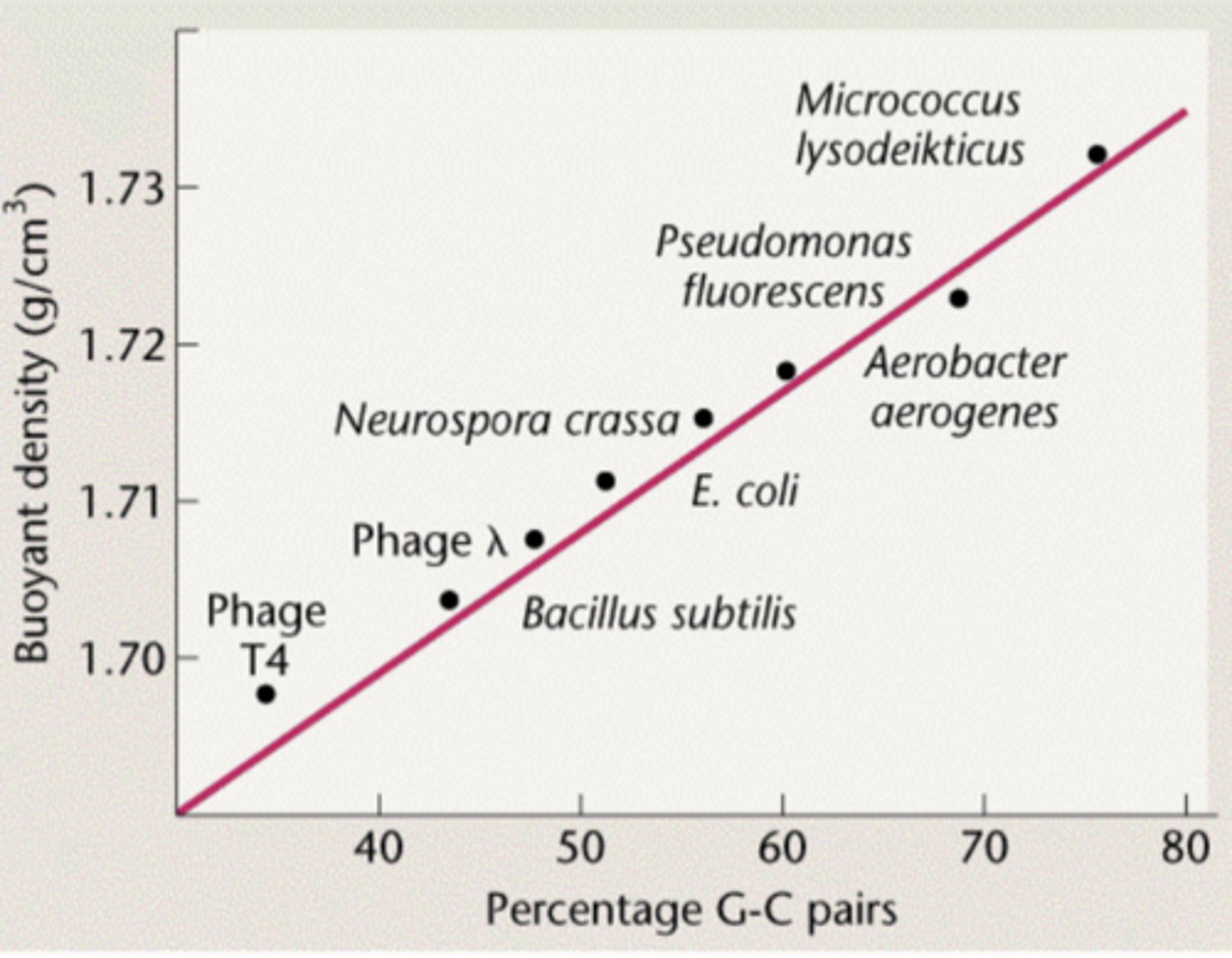
density of DNA depends on its
G+C%
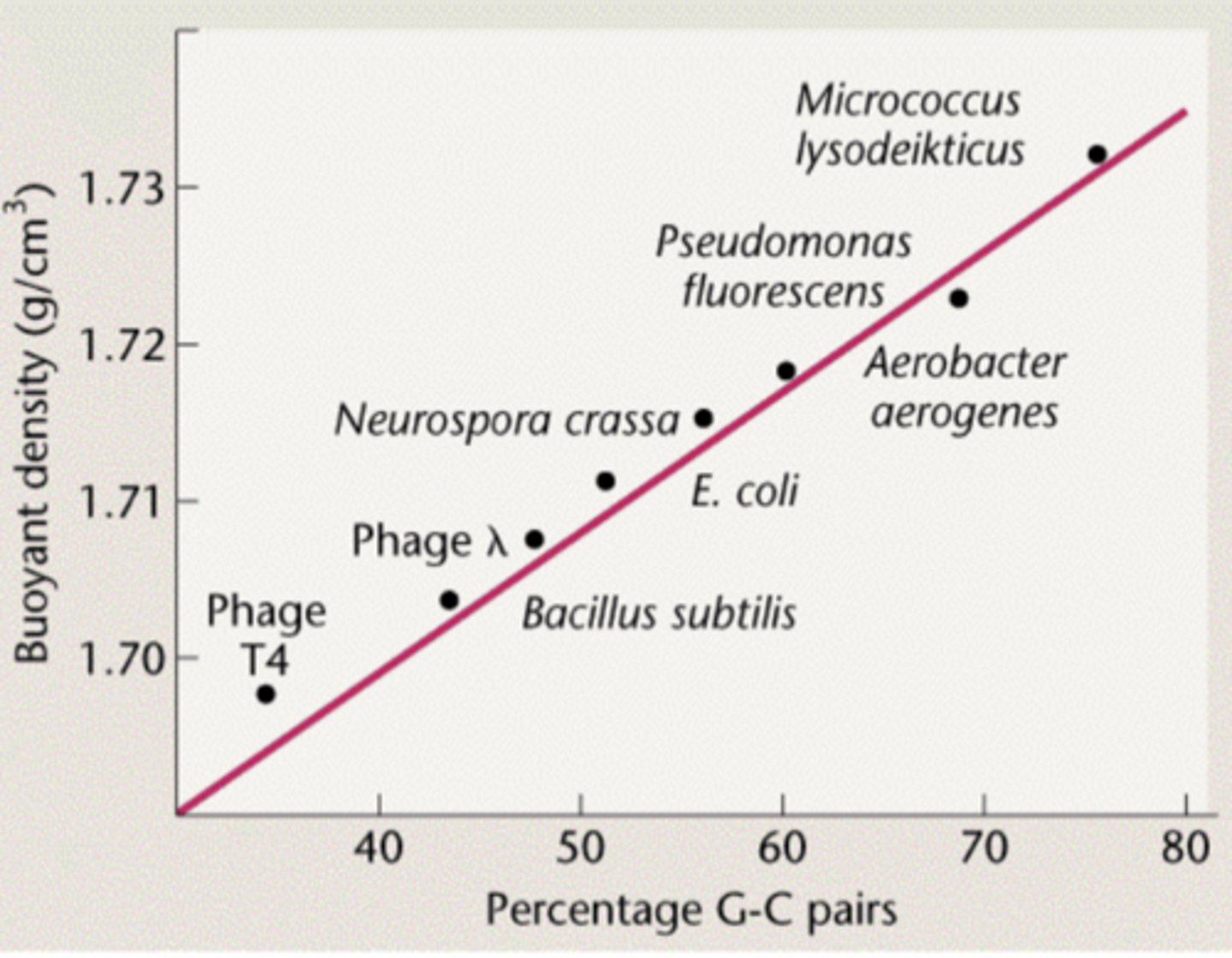
melting temperature increases with
G+C %
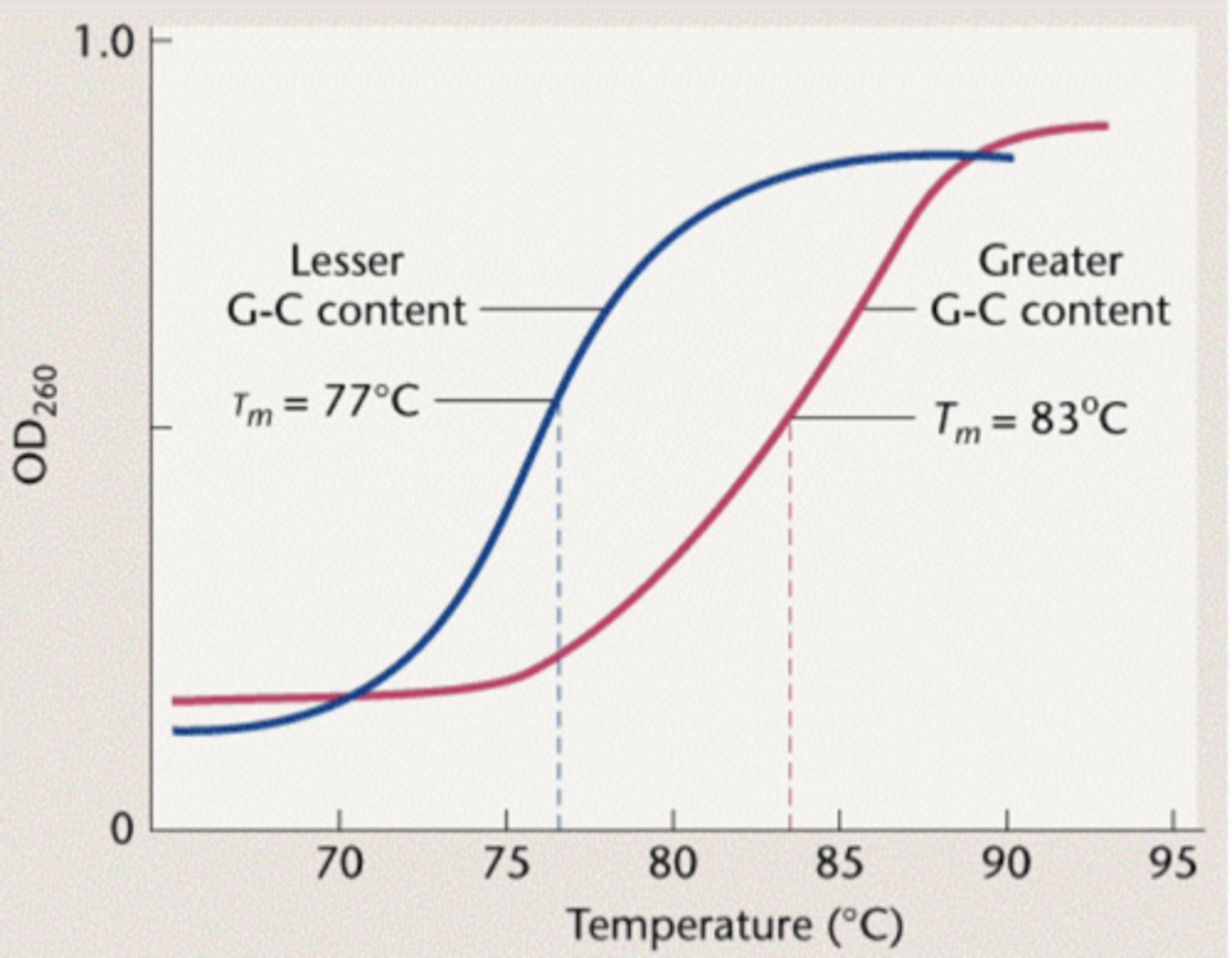
Tm
temp at which DNA is 50% melted
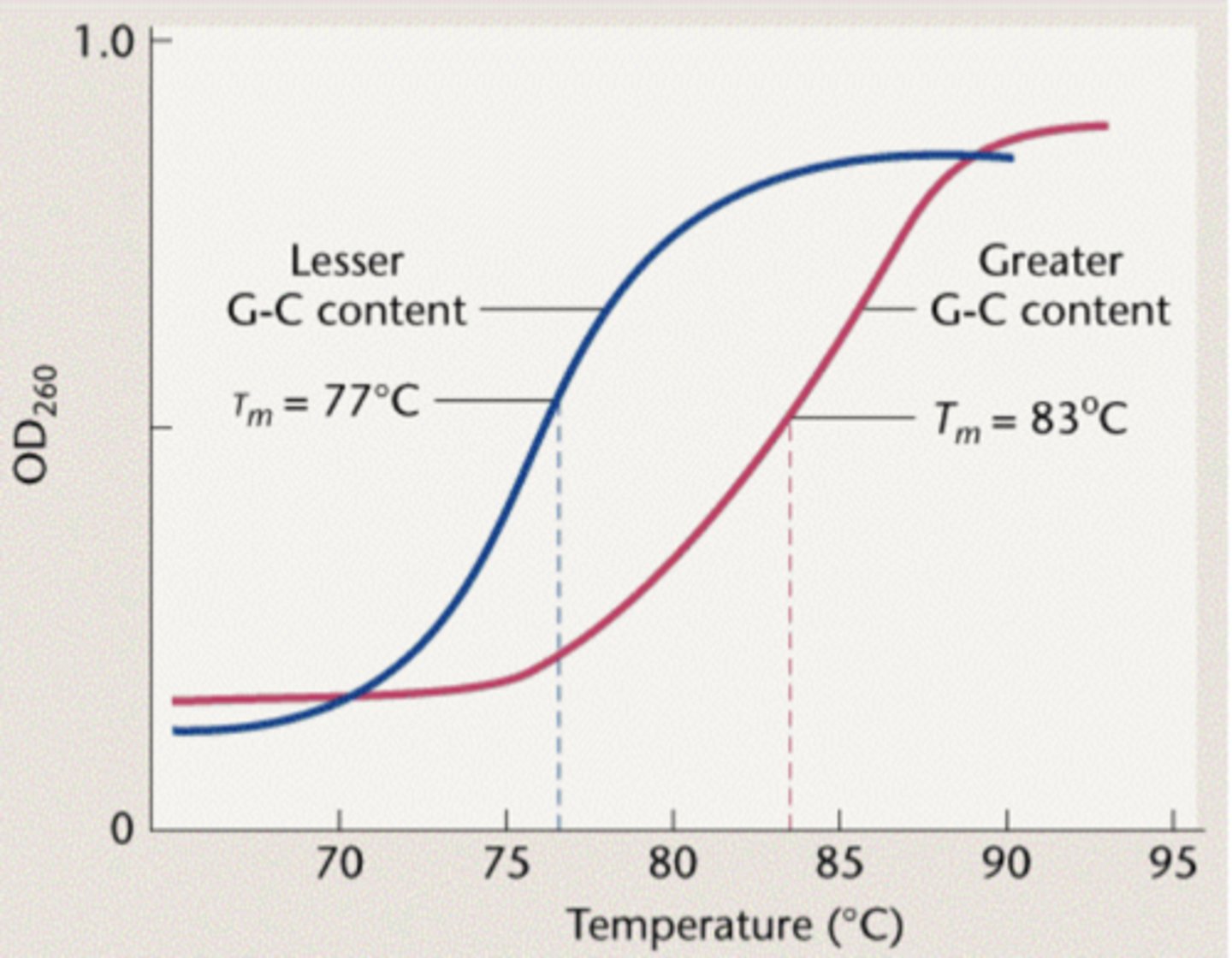
denaturation of dna
separation of complementary strands
-heating and high PH

renaturation of dna
base pairs to reform
-low temp
-low pH

renaturation rate of DNA from different sources is proportional to
genome size
-so-called cot curves
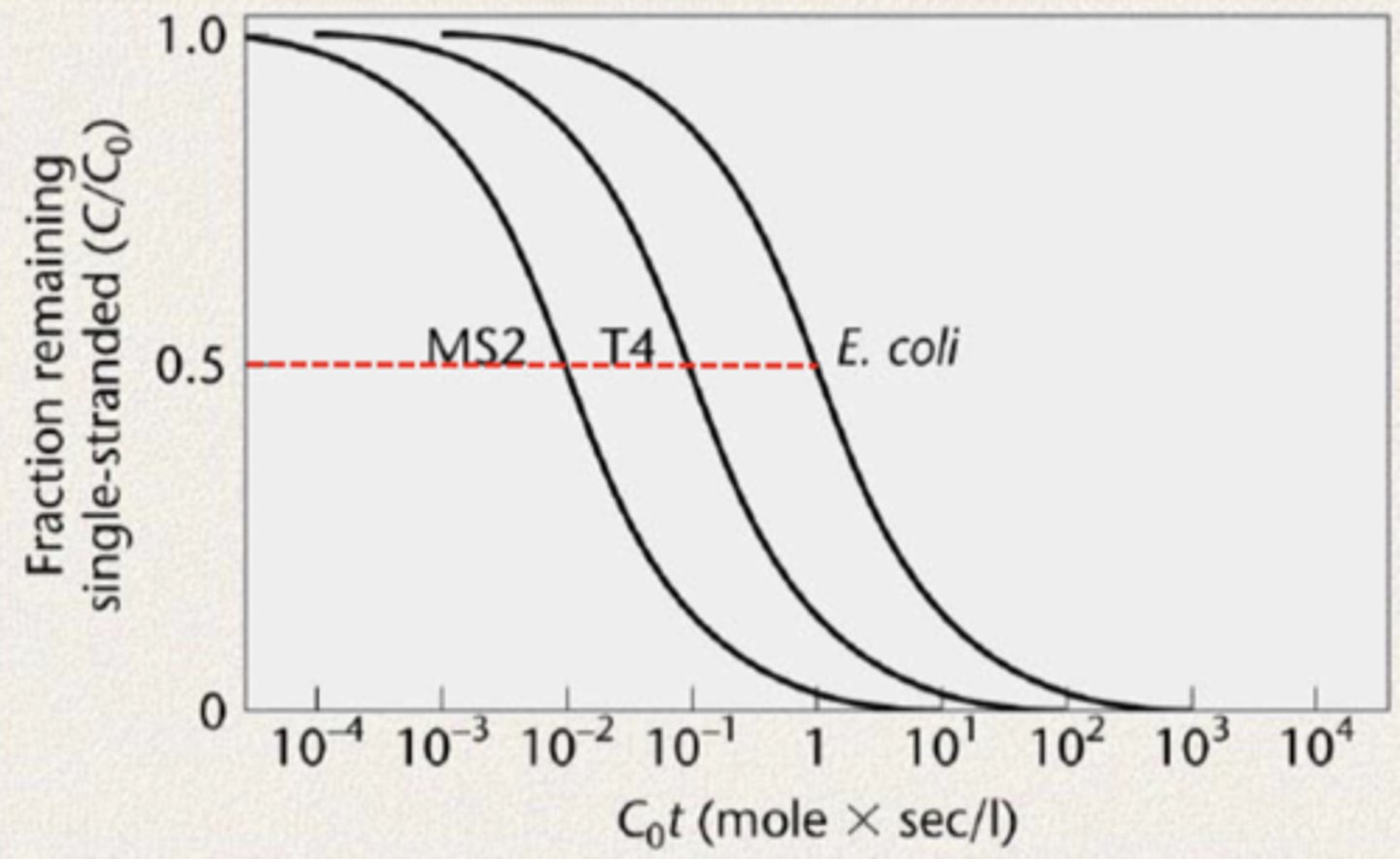
analytical methods are possible because of
biochemical nature of analyzed molecules
analytical methods are based on the unique nature of the
hydrogen bond that is so integral to the structure of nucleic acids
-heated DNA heat denatures (1 molecule becomes 2)
during "melting", the viscosity of nucleic acids
decreases and absorption of UV light increases (hyperchromic shift)
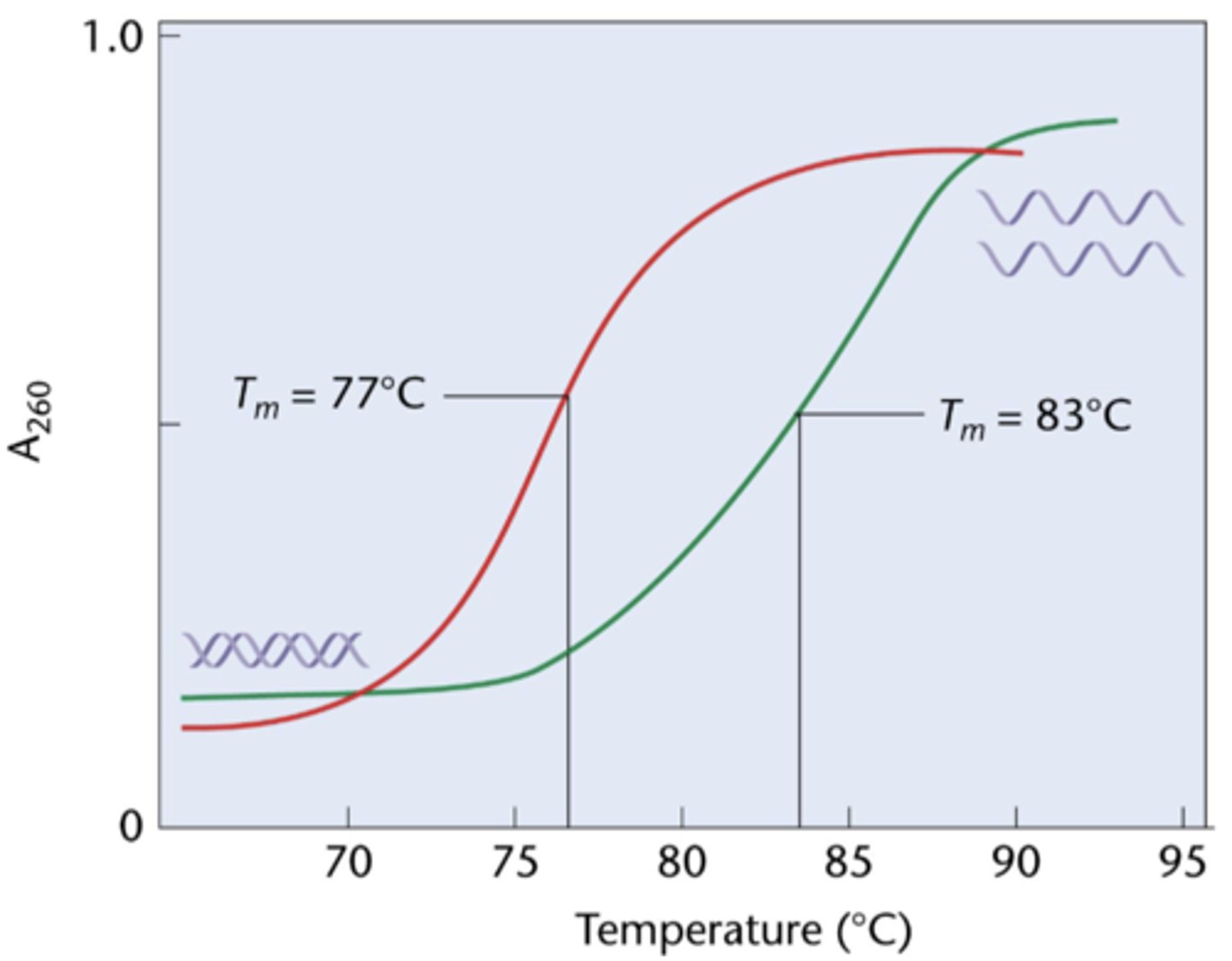
absorbs most strongly at
254-260 nm due to interaction between UV light and ring systems of the bases
hyperchromic shift is used to measure
melting temperature
-informative about base composition of DNA strand (need >̊ to break G=C)
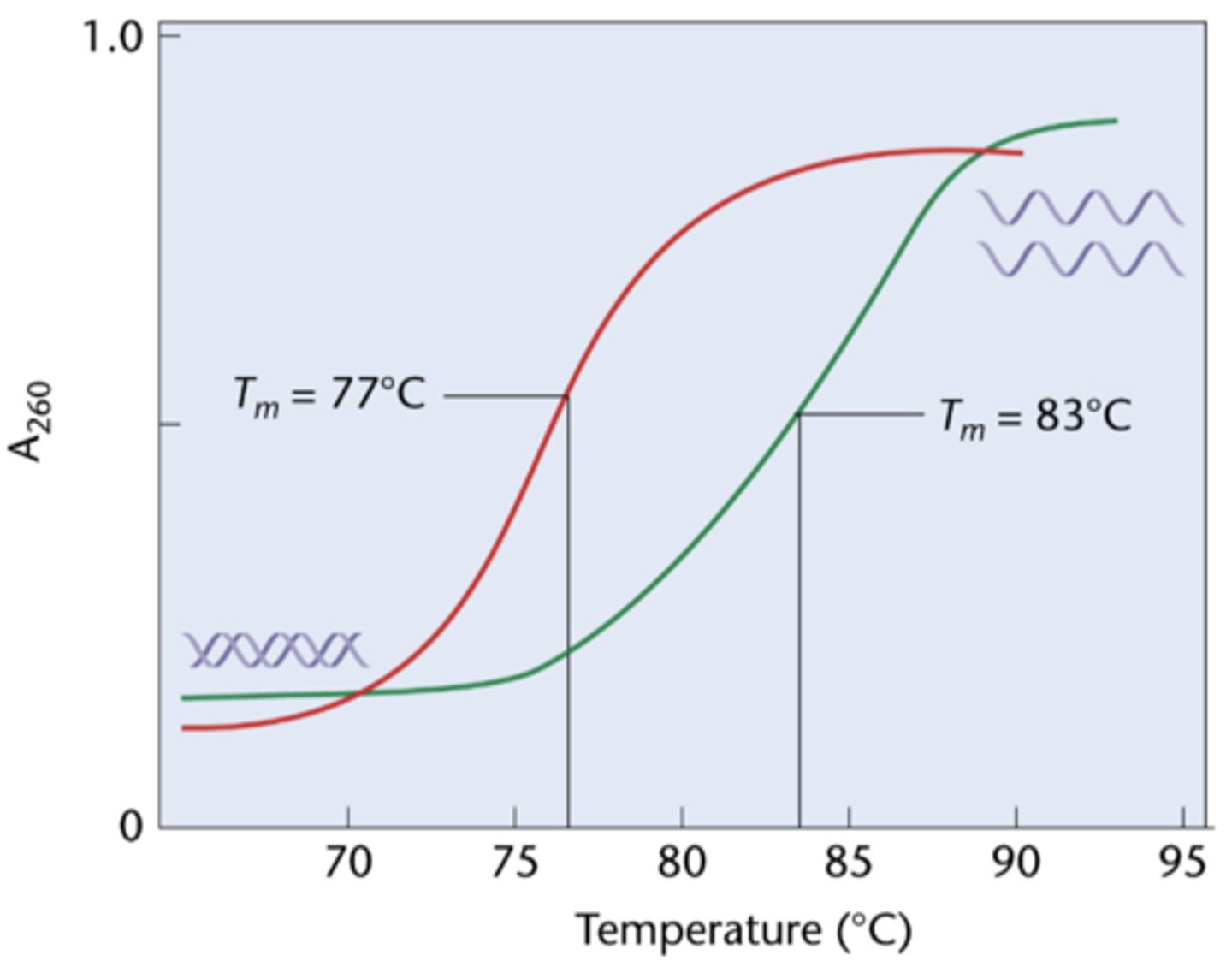
denaturation/renaturation of nucleic acids is the basis for
molecular hybridization
molecular hybridization is possible between
DNA strands of different organisms
RNA molecules will hybridize with
segments of DNA from which it was transcribed
probes are used to identify
complementary sequences
hybridization depends on
complementary base pairing: probe to target
detecting DNA sequences by
molecular hybridization
hybridization can be done with
DNA in solution, on filters, or on chromosomes
B-DNA is the
common form of DNA
-3.4 nm per turn
-10bp per turn
-right handed
A-DNA
-2.6 nm per turn
-11 bp per turn
-right handed
Z-DNA
-3.7 nm per turn
-12 bp per turn
-left handed
-gcgcgcggc or atatatat)
RNA is very similar to DNA, with a couple important differences
different sugars and bases
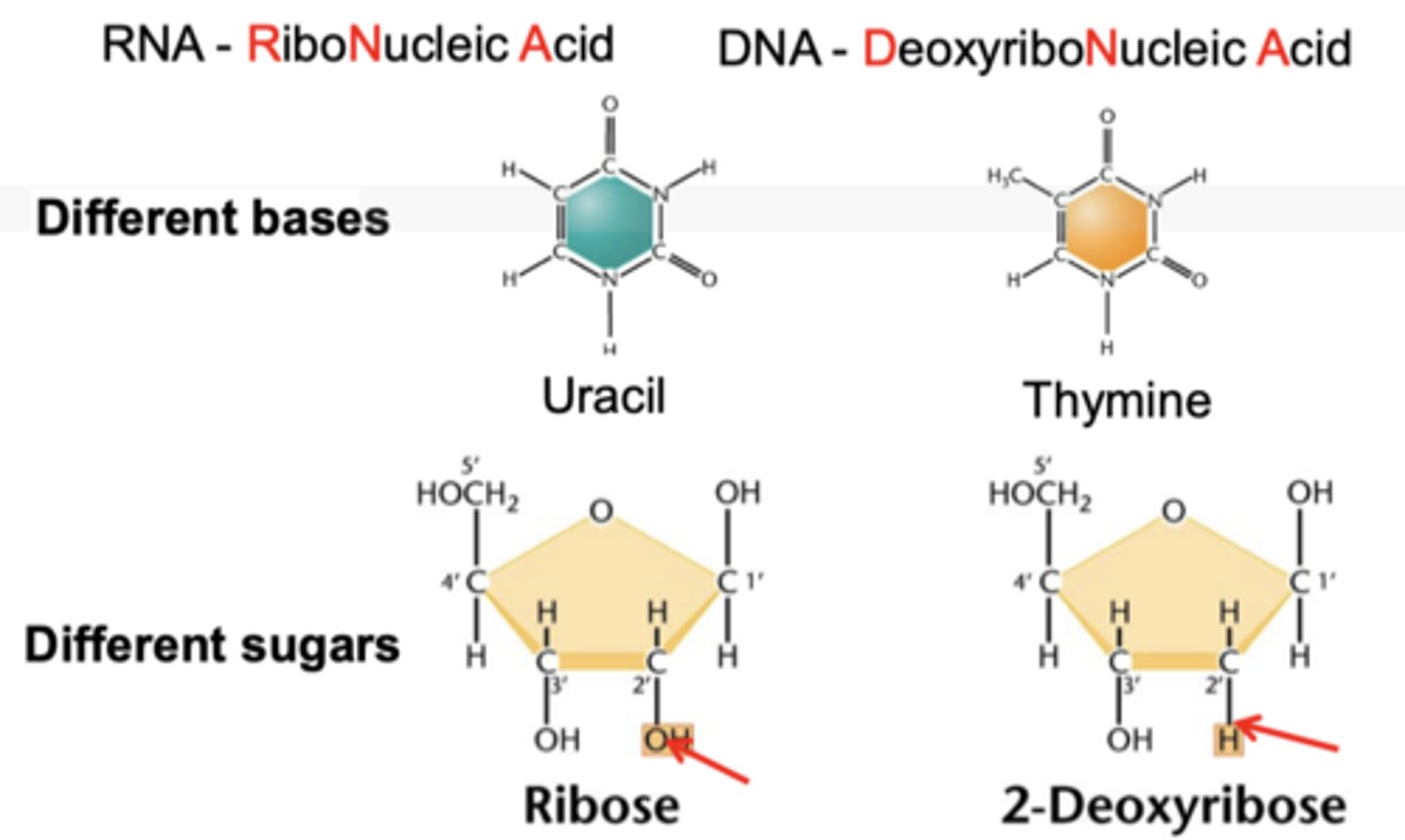
RNA
single stranded but can form double stranded regions by base pairing with itself
-complex structures possible
secondary structure of tRNA
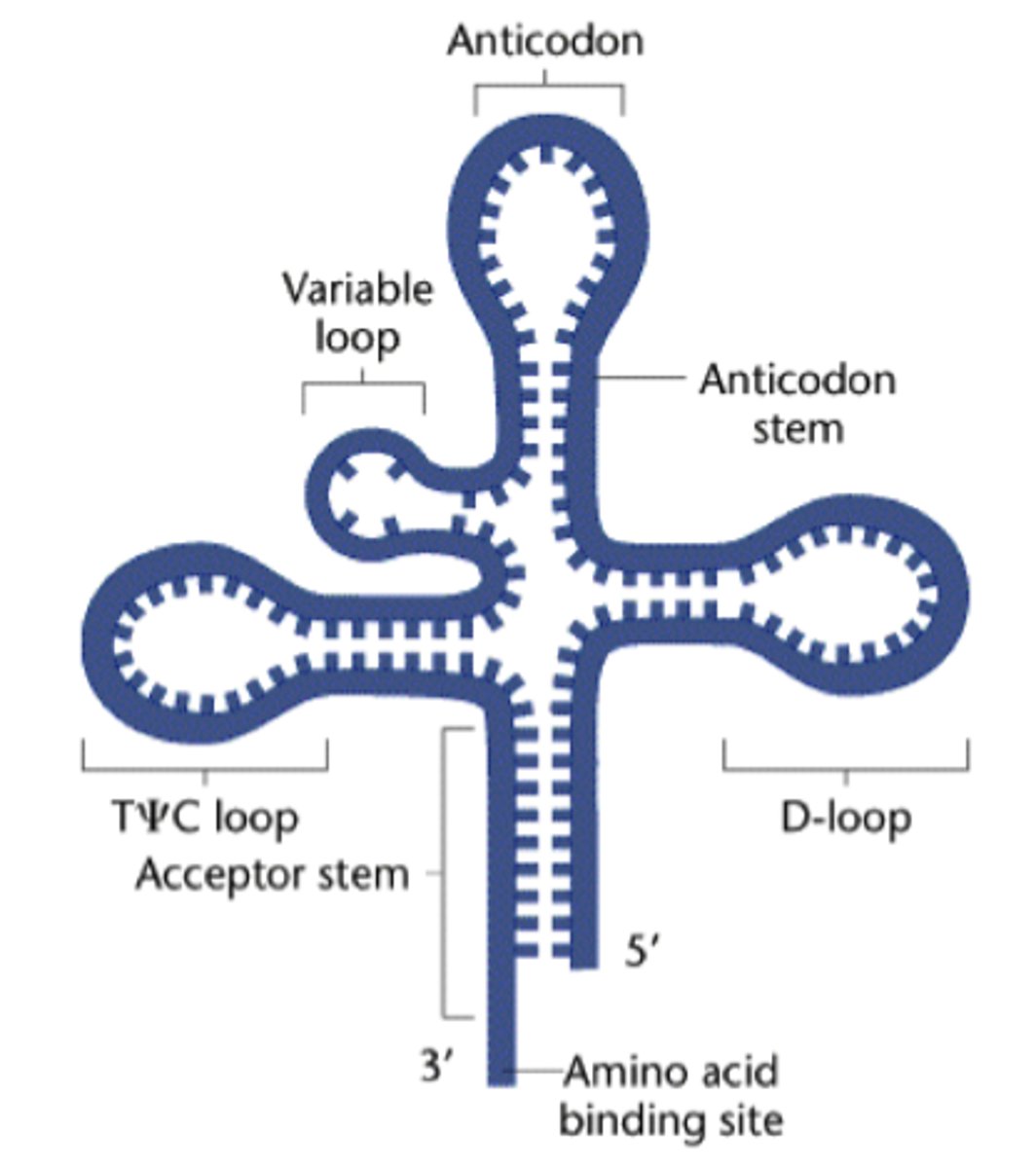
3d structure of tRNA
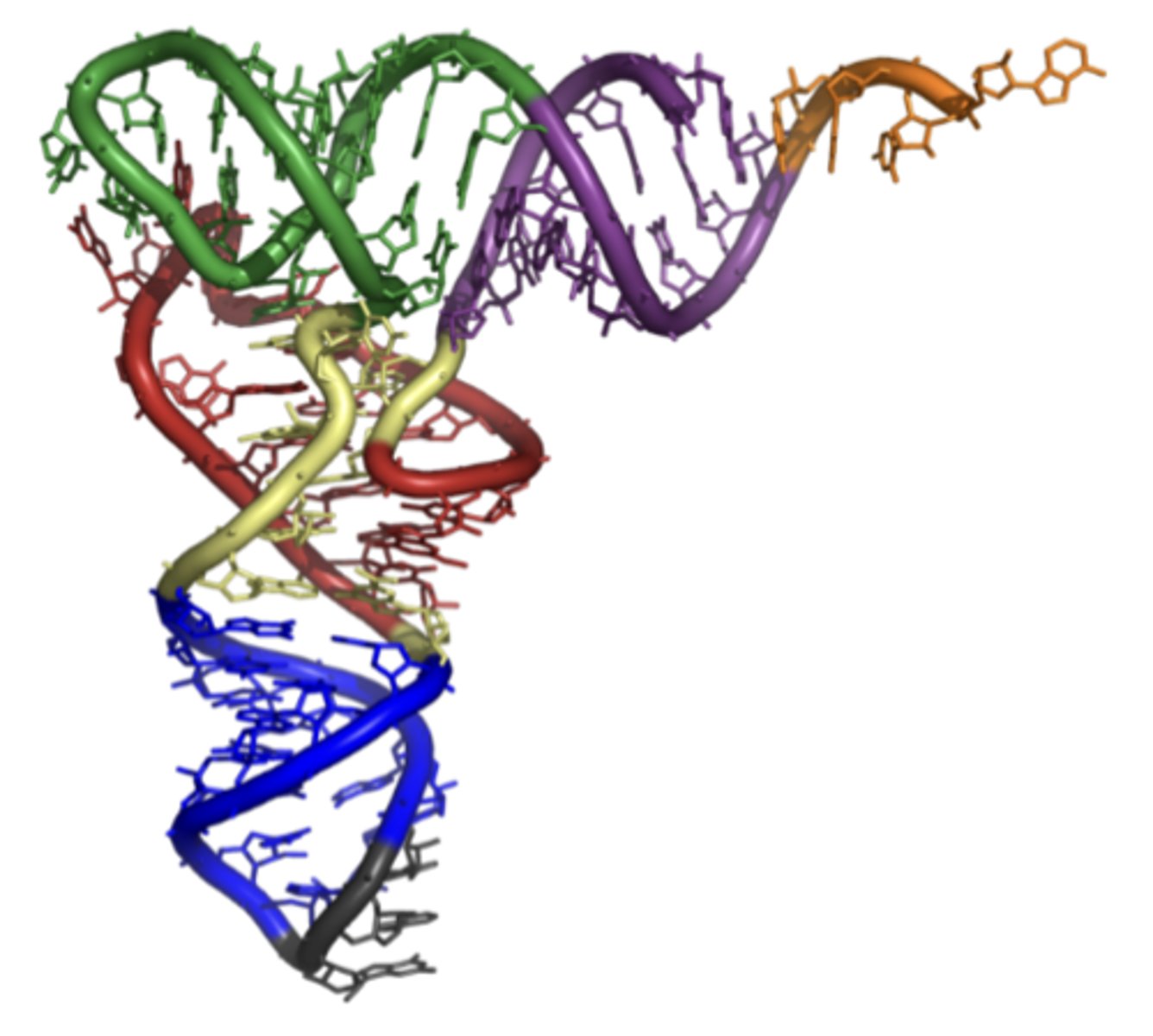
RNA has important
cellular functions
three classes of cellular RNAs that function during
expression of genetic info
-messenger RNA (mRNA)
-ribosomal RNA (rRNA)
-transfer RNA (tRNA)
messenger RNA (mRNA)
carries genetic information from DNA of the gene to the ribosome
-vary in size reflecting size of protein/gene
ribosomal RNA (rRNA)
-largest in size and constitute 80% of all RNA in a cell
-act as work benches during translation
transfer RNA (tRNA)
carries amino acids to ribosomes
in cells, RNA is almost always derived from DNA
RNA all originate as complementary copies of
one of the two DNA strands during transcription
in RNA Uracil replaces
thymine and is complementary to adenine during transcription
ther RNAs exist that perform various roles
-telomerase RNA (tRNA)
-small nuclear RNA (snRNA)
-Antisense RNA
-microRNA (miRNA)
-short interfering RNA (siRNA)
telomerase RNA (tRNA)
DNA replication
mall nuclear RNA (snRNA)
RNA processing